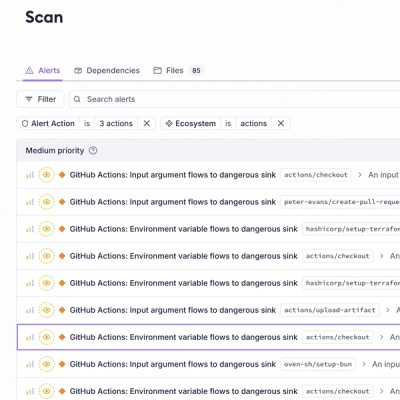
Product
Introducing Socket Firewall Enterprise: Flexible, Configurable Protection for Modern Package Ecosystems
Socket Firewall Enterprise is now available with flexible deployment, configurable policies, and expanded language support.
gatsby-tinacms-json
Advanced tools
A Gatsby/Tina plugin for editing JSON files stored in git.
yarn add gatsby-plugin-tinacms gatsby-tinacms-git gatsby-tinacms-json
Include gatsby-plugin-tinacms, gatsby-tinacms-git, and gatsby-tinacms-json in your config:
gatsby-config.js
module.exports = {
// ...
plugins: [
// ...
{
resolve: 'gatsby-plugin-tinacms',
options: {
plugins: ['gatsby-tinacms-git', 'gatsby-tinacms-json'],
},
},
],
}
There are two approaches to registering JSON forms with Tina. The approach you choose depends on whether the React template is a class or function.
useJsonForm: A Hook used when the template is a function.JsonForm: A Render Props component to use when the template is a class component.In order for the JSON forms to work, you must include the following fields in your dataJson graphql query:
rawJsonfileRelativePathAn example dataQuery in your template might look like this:
query DataQuery($slug: String!) {
dataJson(fields: { slug: { eq: $slug } }) {
id
firstName
lastName
rawJson
fileRelativePath
}
}
Additionally, any fields that are not queried will be deleted when saving content via the CMS.
This is a React Hook for creating Json Forms. This is the recommended approach if your template is a Function Component.
In order to use a form you must register it with the CMS. There are two main approaches to register forms in Tina: page forms and screen plugins. Please refer to the form concepts doc to get clarity on the differences.
Interface
useJsonForm(data): [values, form]
Arguments
data: The data returned from a Gatsby dataJson query.Return
[values, form]
values: The current values to be displayed. This has the same shape as the data argument.form: A reference to the CMS Form object. The form is rarely needed in the template.src/templates/blog-post.js
import { usePlugin } from 'tinacms'
import { useJsonForm } from 'gatsby-tinacms-json'
function BlogPostTemplate(props) {
// Create the form
const [data, form] = useJsonForm(props.data.dataJson)
// Register it with the CMS
usePlugin(form)
return <h1>{data.firstName}</h1>
}
JsonForm is a Render Props
based component for accessing CMS Forms.
This Component is a thin wrapper of useJsonForm and usePlugin. Since React Hooks are
only available within Function Components you will need to use JsonForm if your template is Class Component.
Props
data: The data returned from a Gatsby dataJson query.render({ data, form }): JSX.Element: A function that returns JSX elements
data: The current values to be displayed. This has the same shape as the data in the Json prop.form: A reference to the CMS Form object. The form is rarely needed in the template.src/templates/blog-post.js
import { JsonForm } from 'gatsby-tinacms-json'
class DataTemplate extends React.Component {
render() {
return (
<JsonForm
data={this.props.data.dataJson}
render={({ data }) => {
return <h1>{data.firstName}</h1>
}}
/>
)
}
}
JsonCreatorPlugin: contstructs a content-creator plugin for JSON files.
interface JsonCreatorPlugin {
label: string
fields: Field[]
filename(form: any): Promise<string>
data?(form: any): Promise<any>
}
Example
import { JsonCreatorPlugin } from 'gatsby-tinacms-json'
const CreatePostPlugin = new JsonCreatorPlugin({
label: 'New JSON File',
filename: form => {
return form.filename
},
fields: [
{
name: 'filename',
component: 'text',
label: 'Filename',
placeholder: 'content/data/puppies.json',
description:
'The full path to the new Markdown file, relative to the repository root.',
},
],
})
FAQs
A Gatsby/Tina plugin for **editing JSON files stored in git**.
The npm package gatsby-tinacms-json receives a total of 232 weekly downloads. As such, gatsby-tinacms-json popularity was classified as not popular.
We found that gatsby-tinacms-json demonstrated a not healthy version release cadence and project activity because the last version was released a year ago. It has 12 open source maintainers collaborating on the project.
Did you know?

Socket for GitHub automatically highlights issues in each pull request and monitors the health of all your open source dependencies. Discover the contents of your packages and block harmful activity before you install or update your dependencies.

Product
Socket Firewall Enterprise is now available with flexible deployment, configurable policies, and expanded language support.

Security News
Open source dashboard CNAPulse tracks CVE Numbering Authorities’ publishing activity, highlighting trends and transparency across the CVE ecosystem.

Product
Detect malware, unsafe data flows, and license issues in GitHub Actions with Socket’s new workflow scanning support.